
On the evening of Friday, May 1 in Tomson 280, film historian Rick Altman presented to his audience a recreation of early film exhibition through a program of short film clips, illustrated songs and interactive sing-alongs titled The Living Nickelodeon.
Not to be confused with the popular childrens’ TV channel, the “nickelodeon” of the program’s title refers to the 19th century colloquialism for the earliest form of movie theater. The nomenclature originates from the five cent admission cost and the Greek “odeion,” meaning roofed-over theater.
“[The films] help us understand the early years of cinema, when cinema wasn’t yet cinema,” Altman said. “We – looking retrospectively – we easily assume that cinema is in the center, because it is now, and anything else is embroidered around it. But in fact during this early period, cinema was not yet really its own identity. It was still thought of as an offshoot of other systems and media.”
What started as research for his book, Silent Film Sound, quickly evolved into a larger project.
“I looked into finding this cache of illustrated songs and I knew that they were important, but that there had not been enough of them available for people to see,” Altman said.
In 1998, Altman, along with two of his colleagues, put together The Living Nickelodeon as a way to show modern audiences what film attendance was like for people living in the early 1900s.
“[We wanted] to show people how the programs actually worked. They were not just film programs; that the film was pretty much secondary,” Altman said.
Altman’s message was infused throughout the hour and a half long presentation. Altman, accompanied by Kjersti Anderson ’17, began the show with a musical number, and continued with a variety of silent short films, illustrated slides with live musical accompaniment and silent films that also involved live music.
One of the first silent films featured a large man and a small man engaging in a dramatic fight. The film sported impressive effects: at one point the larger man threw the smaller man high into the air. Though the smaller man had obviously been replaced by a dummy, the cut was clean and surprisingly convincing given the fact that the clip was over 100 years old.
This style of editing did not seem to change the overall effect of the film’s slapstick style that had much of the audience in fits of laughter.
As the program progressed through the 1900s, Altman began to inject music into silent films when appropriate.For example, if someone on screen began to play the piano, Altman would also play piano to give the effect of diagetic sound, since recording audio was not possible at the time.
One of the most enjoyable and unique parts of the presentation were the illustrated slides. Intricately designed, often strange and funny, and painstakingly hand colored, these slides were accompanied by songs performed by Altman. At the end of every song, the audience was asked to join in a round of the chorus. This aspect of The Living Nickelodeon differentiated the performance from most other lectures.
Altman was an overall engaging speaker, often injecting jokes into his performance and occasionally going into the audience during the short film screenings.
Altman’s appearance at St. Olaf was sponsored by the Film Studies Program. Altman has traveled around the world, both individually and in a group, to perform The Living Nickelodeon. The list of performance venues ranges from college campuses such as New York University, to international music festivals like the Bologna Festival in Italy, to world-renowned museums such as the Museum of Modern Art in New York and the Louvre in France.
Altman is also the author of several award-winning books regarding film and cinema studies, including Silent Film Sound, recipient of the Society of Theatre Librarians Prize for best book published in 2004 on recorded performance and the Limina Prize for best film book published in 2004.
When he is not performing, Altman is a professor of cinema at the University of Iowa, and continues his research on early cinema.
neuner1@stolaf.edu
Graphic Credit: ERIN KNADLER/MANITOU MESSENGER

